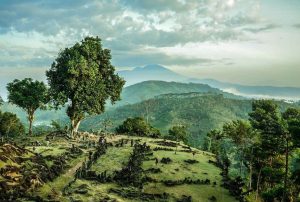
Some consider it the oldest pyramid in human history, while skeptics make compelling arguments about the site's other historical and geological significance. The story surrounding the sacred site of Gunung Padang in Indonesia has been swirling for decades.
There is an ongoing debate over which pyramid in the world is the oldest. However, an article in a specialized historical journal Archaeological Prospection magazine claims that such a place could be Gunung Padang in Indonesia.
The media writes that the oldest pyramid of Djoser in Egypt, built around 2600 BC, was considered the oldest. However, the article shows that the mentioned object in Indonesia may be at least 9,000 years ancient, and its individual parts are dated to 25,000 years ago.


Gunung Padang is an archaeological site located in Karyamukti, West Java, Indonesia. The property, located at an altitude of 885 meters above sea level, covers a hill – an extinct volcano – forming a series of five terraces surrounded by stone retaining walls, accessed by 370 successive andesitic steps rising to a height of approximately 95 meters (312 feet). .
It is covered with massive hexagonal stone columns of volcanic origin. The Sundanese consider this place sacred and believe it was created as a result of King Siliwangi's attempt to build a palace in one night.
Gunung Padang literally means “mountain of enlightenment” and has been visited by people for hundreds of years. Pottery fragments dating back to 45 BC were found on scattered terraces and pillar-like rocks.
A group of researchers from the Indonesian Institute of Sciences, led by geologist Danny Hilman Natawidjaja, believe that Gunung Padang was built by a “highly advanced civilization” and that the feature “may be older than the Egyptian pyramids.”


The study says: “This discovery challenges the conventional belief that human civilization and the development of advanced construction techniques only emerged during the warm period of the early Holocene or early Neolithic, with the emergence of agriculture around 11,000 years ago.
“However, evidence from Gunung Padang and other sites such as Göbekli Tepe suggests that advanced construction practices were used even when agriculture had perhaps not yet been invented.”
Scientists say evidence from Gunung Padang and elsewhere suggests advanced construction techniques already existed “before agriculture was probably invented.”
However, not everyone shares the researchers' opinion. In 2013, The Guardian reported that a group of 34 Indonesian scientists had signed a petition questioning the motives and methods of Danny Hilman Natawidjaja's team. They said the research was conducted without “adhering to scientific research standards.”
Critics say the excavation threatens the preservation of the existing site and suggest that archaeologists, not geologists, should be involved. One of them, volcanologist Sutikno Bronto, claims that Gunung Padang is simply “the crater of a nearby volcano, not an ancient pyramid.”
Other skeptics are even more brazen. One anonymous archaeologist claims that local politicians were involved in popularizing this view, profiting from such speculations to gain political approval.


“In Pawon Cave in Padalaranga [about 45 km from Gunung Padang]My colleagues and I found human bones and tools made of bones. They have approximately 9.5 thousand years, i.e. they were created about 7 thousand. years BC So if in the 7th millennium BC people could only make tools from bones, how could they have obtained the technology to build a pyramid 20,000 years ago? – asks the expert.
Since the 1980s, a number of detailed studies have been carried out at Gunung Padang, but researchers still disagree about its age. In 1982, B. M. Kim dated the site to between 300 and 2000 BC
But even these estimates are mild compared to the most shocking estimate of all – that Gunung Padang's deepest layers are between 16,000 and 27,000 years old. This would make Gunung Padang the oldest pyramid in the world.
Natawidjaja emphasized that his team's research and surveys were multidisciplinary (not just volcanological) in nature, and while a volcanic intrusion did take place, there is more to the story.
“Our comprehensive study, which includes geological, archaeological and geophysical surveys, has indeed confirmed the existence of an underground 'volcanic intrusion'. […] coincides with Sutikno's observations,” says Natawidjaja. “However, our findings also present compelling evidence that challenges the perception of Gunung Padang as simply the neck of a nearby volcano.”
“Our research conclusively shows that it is indeed a mortar and not a by-product of natural aging. Our team of experienced geologists examined and analyzed the samples in detail, leaving no room for doubt as to their origin,” says Natawidjaja.
Image Source: Pixabay.com





